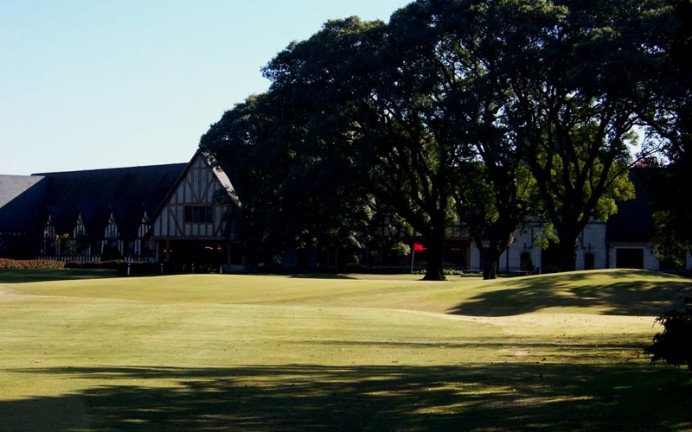A Dream Course
June, 2014
The legendary writer Pat Ward-Thomas did the world an immense favor when he penned his ‘Elements of Greatness – a Classic Course’ for the World Atlas of Golf in 1976. It put the spotlight squarely on individual golf holes, something that wasn’t done much back in the 1970s. His rationale and exquisite British writing style make for a fascinating read, decade after decade.
Anyone who follows him does exactly that: follow him. His vision/idea and the original publication of those hole by hole drawings will never be matched. Nonetheless, a very great many holes lend themselves to this undertaking that I sheepishly have elected to blunder forth with my own version.
My selections appeal to me and my 7 handicap as playable but I imagine/hope that they would be engaging for better players as well as weaker ones. I spent three hours compiling the set and the yardages are approximations of where I would like to play the holes. There is minimum water and beating tall rough in search of golf balls should occur infrequently.
Variety is critical in these type lists and there are never more than two holes in a row with the same par. The course below is comprised exclusively of holes built prior to World War II. A modern version will follow in time (and maybe a heathland one after that!).
Card of the Course
First hole, Yeamans Hall, 425 yards; It is 2014 and I disagree with Donald Ross’s concept of “a gentle handshake.” I’ve come to PLAY golf (not PRACTICE), time is tight, and my wobbly back is unlikely to produce a smooth swing. I am leery of the easy-ish opener where I make a bogey and grump my way to the second tee in disgust. Give me a hole like the first at Sand Hills where I can unwind or a hole here where I am ‘not unsatisfied’ with a bogey. Yeamans fits that bill better than Oakmont or Winged Foot West where even a bogey is a victory a bit too often. Plus the first tee at Yeamans is perfectly melded into the putting green, practice and clubhouse areas. The tone is set, and then carried out through the rest of the round, of hitting to generous landing areas off the tee with the challenge stiffening at the green.
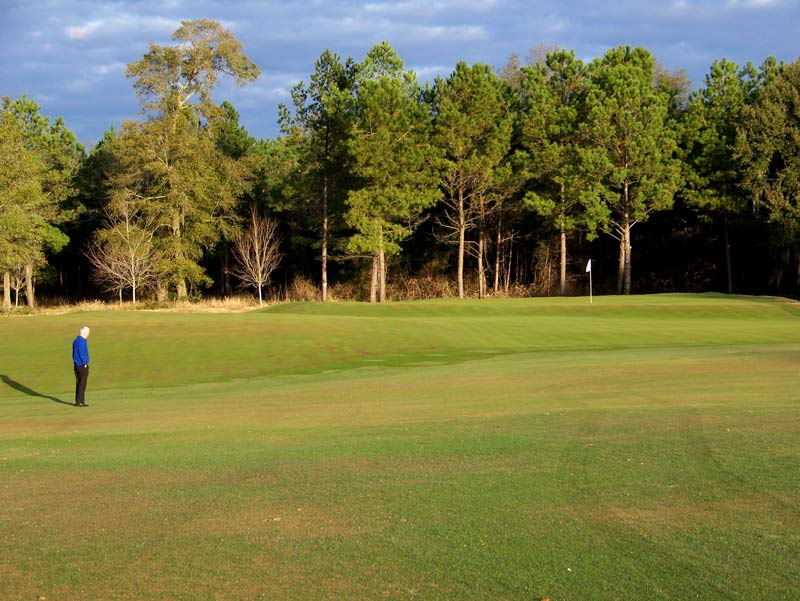
Given that the green is the ultimate target, then the ultimate course must have great greens. My course does with the stunning Double Plateau at Yeamans a clear signal of the adventures that lie ahead. A tip of the hat to the late great George Bahto as we head to the second tee.
Second hole, Garden City, 130 yards; Forty years of playing has convinced me that nothing spaces out subsequent play better than par 3s. Let’s get one early so that we don’t have to look at the backsides of those in front for the rest of the day. In order to best vary length within my group of one shotters, Garden City fits better than the wonderful one at Somerset Hills.
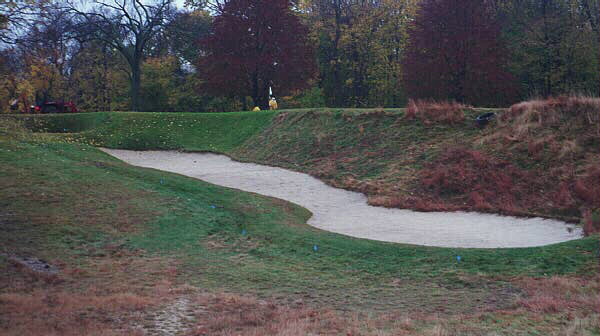
An early test of precision. Unlike with a man-made water hazard, this one offers a chance to demonstrate recovery skills.
Third hole, Royal County Down, 450 yards; Josh Smith’s painting of this hole hangs over my desk and it takes my breath away each and every morning when I sit down. Strategy abounds because certain hole locations are only visible from certain areas of the fairway but this bruiser still allows the lesser player to muddle along without undue injury. The third hole (Pond) at The Country Club or Deal would also do just fine.
Fourth hole, Woking, 330 yards; What golf architecture snob wouldn’t pick this hole?! It encapsulates so much of the history of design and man’s ability to imbue strategic playing interest inland. Plus, I am a glutton for greens that tilt front to back .
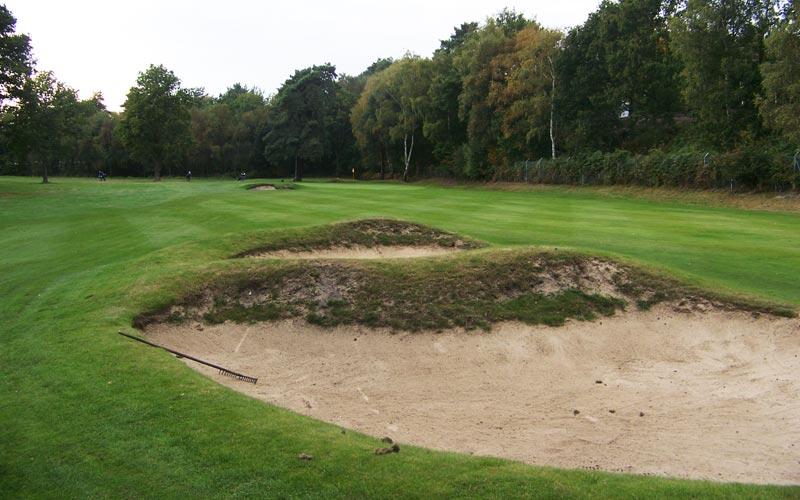
The brilliance of Paton’s fairway bunkers is that they are where the golfer wants to hit his tee ball.
Fifth hole, Pinehurst No.2, 510 yards; Golf is largely formulaic: the eighteenth hole ends near the start of the first and par is rigidly calculated according to length. This hole isn’t easily stereotyped. Indeed, it is a favored ½ par, and you will see plenty more throughout this round. This one is distinguished by an extraordinary putting surface that embodies the maddeningly best qualities of Pinehurst’s crowned greens.

Most second shots on par 5s are deathly dull; not the risk/reward one here! Even if you elect to lay-up, great care still needs to be taken.
Sixth hole, Royal Melbourne West, 420 yards; An architect must do all he can to keep the golfer slightly off balance. Certainly, he should not allow one shot shape to dominate play: make the golfer hit all sorts of different shots even when the wind is down. Here we have the perfect complement to the 5th at Pinehurst, bending in the opposite direction. If these two greens don’t give you conniptions, then you are made of sturdy stuff.
Seventh hole, St. Germain, 160 yards; Every eclectic eighteen must by law – or at least by common sense – include a one shotter from Harry Colt. Whether Colt benched greens into a hill (4th at Swinley Forest) or built push-up green pads like this one, his one shotters are always a treat. As a set, the one shotters at the beautifully restored St. Germain are among his very best and Colt expert Paul Turner considers the 7th to be stylistically unique.
Eighth hole, Eastward Ho!, 350 yards; The stepchild of golf is presently the intermediate par 4. No one talks about these holes that surely comprise the underpinning of most courses. So, we’ve chosen this wind-swept 350 yarder as a fine example of a 400 yarder! Be sure that with the prevailing headwind this uphill hole plays at least 50 yards longer than the scorecard suggests. This hole epitomizes the currently neglected, under-appreciated driver/8 iron hole that no one writes about. Let’s change that trend and celebrate the glories of holes 350 to 400 yards like the 2nd at the Old Course, the 9th at Lahinch, the 13th’s at West Sussex and Cypress Point, the 15th at Somerset Hills, etc. to prompt more exemplary ones to be built.
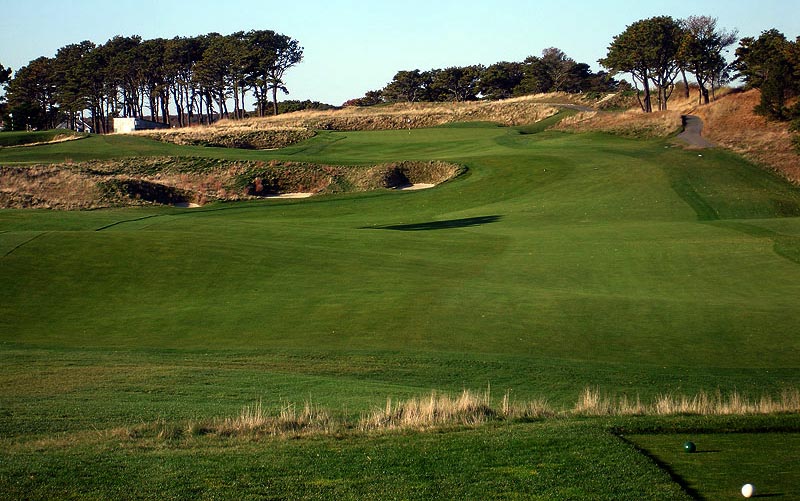
The most handsome eighth offers just as much playing qualities as holes much longer. A true placement hole, the back right to front left tilt of the green is evident even from this distance. Snuggling up near the fairway bunkers with your tee ball provides the best angle into most hole locations.
Ninth hole, Royal North Devon, 480 yards; Eclectic lists can bombard the golfer into sensory overload. A quiet hole is a must and while the scorecard and the wide view from the tee portend a birdie opportunity, a brilliantly positioned knob at the green tactically elevates play. On such a vast playing field, it’s amazing how quickly out of position a golfer can find himself. In many ways, this is architecture at its (subtle) best. Juxtaposing the two “Ho!s” is too rich not to do so the eighth at Huntercombe and NGLA’s Bottle are left out for another version.
Tenth hole, Riviera, 310 yards; Why Mr. Ward-Thomas didn’t pick this gem is a mystery. Part of the wisdom in selecting this back nine starter is that it makes for a perfect 1/2 par first play-off hole, which nudges it past another supremely bunkered hole, the 10th at San Francisco Golf Club.
Eleventh hole, Essex County MA (though the one in NJ is first rate too), 175 yards; My good friend Joe Andriole has a predilection for uphill par 3s and regularly travels to the northeast from his home in Orlando to quench that thirst! Modern architects ludicrously do unnatural acts to produce downhill par 3s within their routings with the end result being courses that are dreadful to walk. Not Donald Ross and the other Golden Age architects. This uphiller is just as striking – and satisfying to play – as any downhiller you care to mention.
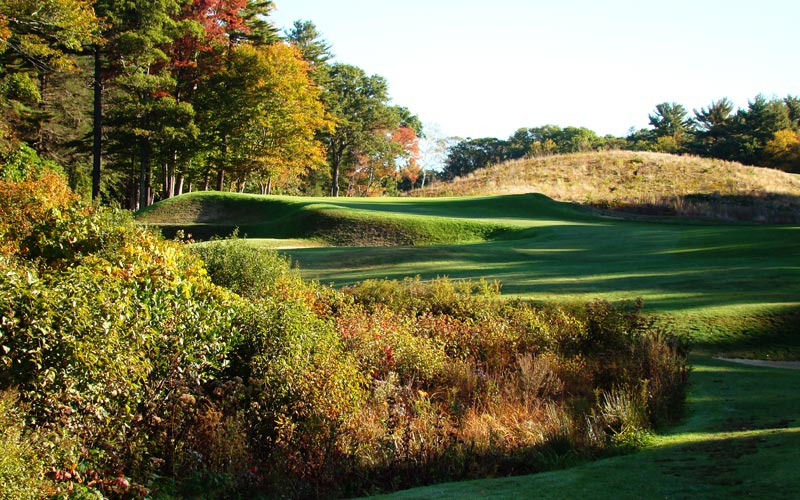
Golden Age architects appreciated uphill par 3s in part because it provides an opportunity to build effortlessly deep greenside bunkers.
Twelfth hole, Askernish, 560 yards; You might think that the water laden par 5s at Augusta make a terrific tandem? Of course they do, but so do the pair on my course. The three distinct paths off this tee make the 12th a must and it’s another front to back green added into the mix. Nonetheless, excluding Sunningdale Old’s superb hole is painful.
Thirteenth hole, Prestwick, 440 yards; Old Tom Morris smoothed over and put into play this green complex over 150 years ago. The Club has acted as wise custodians so that hole remains every bit the menace that it was when the first Open Championship was played here in ….. wait ….. 1860! Today’s advanced green keeping practices cause many players to shriek “UNFAIR” as the angled knob of the green rountinely repels their 200 yard approaches. Once the card and pencil set start complaining, you may well be on to something truly special!

A modern architect would get crucified for building a green like this at the end of a long hole. A great course can sustain at least one such hole.
Fourteenth hole, The Old Course at St. Andrews, 530 yards; Hazards directly in the line of play are what really matter; window dressing to the sides of holes merely penalize the inept. The better the hazard, the more dramatic its effect and certainly Hell’s Bunker makes a deep impact in that regard. It is so well known, so imposing, so famous that it has overshadowed one of the game’s all-time great green complexes. The kenspeckled (as an Old Scot might say!) protuberance to the front of this green shunts balls every which-way. For the author, the out of bounds off the tee (a gut tightening feature that is expertly deployed mid-way through the second nine) and the contorted green confound the modern player more than Hell’s Bunker. These diverse points of challenge have allowed Long to – magnificently – withstand the test of time. Nonetheless, it is somewhat shameless to pick this and the next as that’s exactly what Mr. Ward-Thomas did. The 14th at Royal St. George’s and the 15th at Capilano make for admirable substitutions if the ‘no copying’ rule was in effect.
Fifteenth hole, Oakmont, 430 yards; Inland golf offers its own variety of breathtaking moments and glimpsing this massive 54 yard long green complex after cresting the hill is emphatically one of them. Part of Oakmont’s brilliance is found in the areas fronting the putting surfaces and the 15th is case study A1. Watching a golf ball slowly drift on tightly mown short grass is one of the game’s great, relaxed joys and this green complex provides that thrill as well as any in the world. Only a hole of this design magnitude would cause Haagsche’s to be left out.
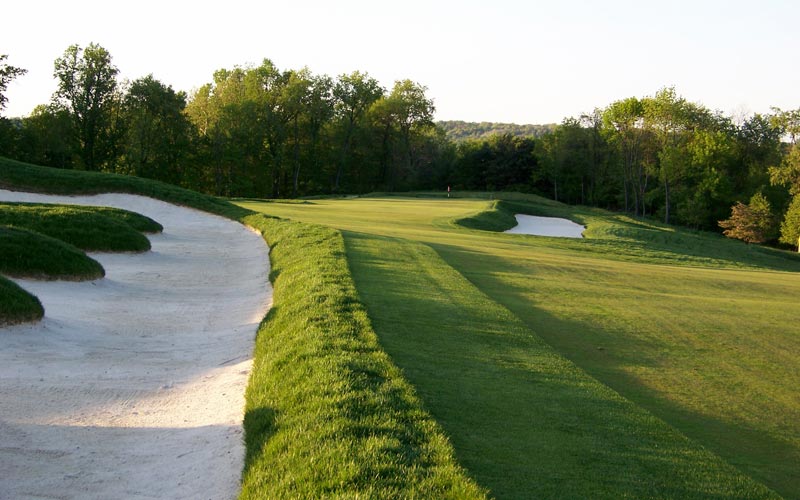
Blind from the tee, the green complex’s scale only becomes evident once the golfer reaches his tee ball.

Yes, the hole is hard for the tiger but the open area in front of the green makes it playable for mere mortals as well.
Sixteenth hole, Cypress Point, 230 yards; So many outstanding options – North Berwick, Seminole, Deal, Shinnecock, Merion, Walton Heath, the list goes on and on – and yet there is really only the one: the game’s finest hole. Other than the originator of this exercise, who wouldn’t pick it?!

Forget a thousand, this photograph is worth a billion words and is the epitome of man working with nature.
Seventeenth hole, Durban, 400 yards; Golf at its highest level it most assuredly a ground game so the better the topography, the better the hole. Here, Mother Nature’s random, windswept landforms are expertly captured within the playing corridor. Banal architects utilize water when they are out of ideas or when the course will be featured on television. Either way, little hope exists that a great hole will emerge. Keep golf as a ground game and something more enduring emerges, a message this penultimate hole soundly delivers.
Eighteenth hole, Jockey Club (Red Course), 355 yards; By all means, we must end with a hole that actually makes you want to play again. Options abound including Falsterbo, YHC, NGLA and the Old Course at St. Andrews. Yet, a tip of the hat needs to go to my favorite all-time architect and a hole whereby he replicated a favorite feature from his all-time favorite course. Plus, the stately clubhouse at the Jockey Club will do nicely as a place to repair for drinks.
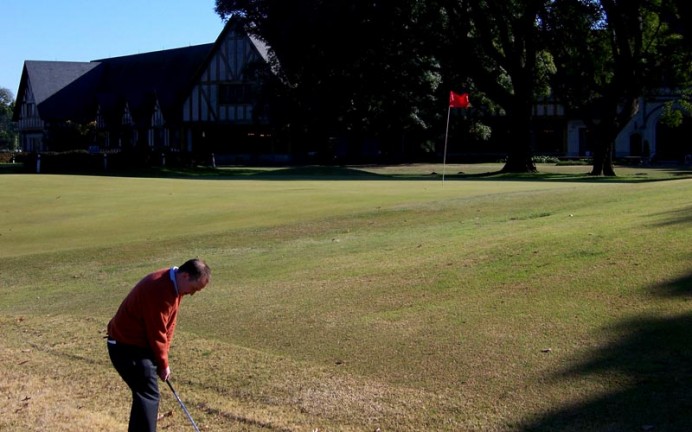
… into making a tricky up and down from the Valley of Sin. Ben Cowan-Dewar will vouch for how 2 shots can quickly – and tragically – become 3. Nothing displays frayed nerves at the end of a match better than short grass.
There you have it. Par is a full 72 and the action packed distance is 6,680 yards (3,245 yards on the front and 3,435 yards coming home). I am not thrilled that the course is that long but the length largely comes from the pair of long three shotters on the second nine. I could easily reduce it to a par of 71 and drop the yardage nearly 400 yards (!) by substituting Maidstone as my 14th hole. Yet, I am a fan of multi-option three shotters so there you have it.
The beauty of lists like this is that everyone can argue with everything and no two lists would ever be the same. Some might argue that my eclectic course is even worse than Pine Valley or NGLA! Do I really think the Jockey Club’s Home hole is better than the one at Pebble? No, of course not, but I tried to piece together a course that wouldn’t overwhelm the player’s sensory perception or ability. It’s tempting to lump together each great course’s greatest challenge, like the fourth at Seminole, ninth at Yale, twelfth at Southern Hills, thirteenth at Pine Valley et al. Pretty soon, that wantonness creates a course on which you can’t break 90 even when you strike it well. Thus, a hole like the 5th at the Sacred Nine (Royal Worlington) is excluded; it’s the lynchpin on that design masterpiece but too murderously difficult to include in a compilation. There must be “give” as there is a lot of “take” with this exercise.
Above all, the resulting course must be tons of fun and I hope that you agree this one is.
Best,
Ran Morrissett
Southern Pines, North Carolina
The End








